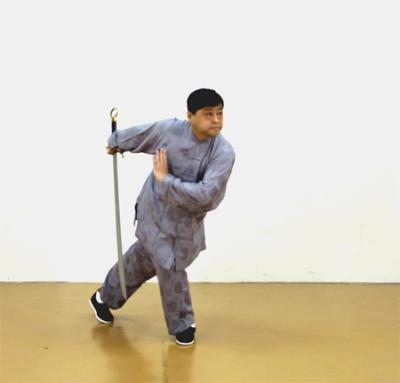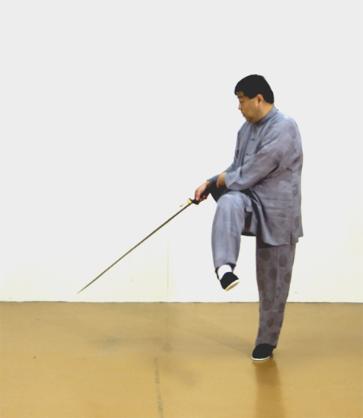
4. How to Practice Taiji Dao
Taiji Dao practice should base on correct Taiji Quan practice. Without mastering Taiji Quan skills, no one can really understand and do Taiji Dao skill
in the correct manner.
There are several steps for practicing Taiji Dao:
(1) Basic Skill Practice
People always say a weapon is just an extension of our arm. So before we can practice any weapons skill, we should practice many basic skills to
make ourselves very familiar and comfortable while holding the weapon in hand. It is common to use circling practice. Of course, first, one should get a
suitable sword (in length, weight, and balance).
(2) Form Practice
There is a 13 posture Taiji Dao form practiced in traditional Taiji Quan group. After many generations, today the form may be slightly different for
different groups, but all basic principles and skills should be same. There is a poem of the form which gives all the posture names.
Taiji Dao practice should base on correct Taiji Quan practice. Without mastering Taiji Quan skills, no one can really understand and do Taiji Dao skill
in the correct manner.
There are several steps for practicing Taiji Dao:
(1) Basic Skill Practice
People always say a weapon is just an extension of our arm. So before we can practice any weapons skill, we should practice many basic skills to
make ourselves very familiar and comfortable while holding the weapon in hand. It is common to use circling practice. Of course, first, one should get a
suitable sword (in length, weight, and balance).
(2) Form Practice
There is a 13 posture Taiji Dao form practiced in traditional Taiji Quan group. After many generations, today the form may be slightly different for
different groups, but all basic principles and skills should be same. There is a poem of the form which gives all the posture names.
Figure 15: the 13 posture form
1. Qi Xing Kua Hu Jiao Dao Shi - Seven Stars, Ride Tiger, and Hand Over Dao
2. Shan Zhan Teng Nuo Yi Qi Yang - Dodge and Focus, Jump and Move, Excite Mind and Qi
3. Zuo Gu You Pan Liang Fen Zhang - Guard Left and Right, Opening and Extending Two Times
4. Bai He Liang Chi Wu Xing Zhang - White Crane Spreads Wings and Wuxing Palm
5. Feng Juan He Hua Yie Di Cang - Wind-Swept Lotus Flower Hidden Beneath Leaves
6. Yu Nü Chuan Suo Ba Fang Shi - Fair Lady Passes the Shuttle in Eight Directions
7. San Xing Kai He Zi Zhu Zhang - Three Stars Open and Close Freely and Naturally
8. Er Qi Jiao Lai Da Hu Shi - Double-Kick and Strike Tiger
9. Pi Shen Xie Gua Yuan Yang Jiao - Slant and Twist Body Sideways, Diagonal Block and Mandarin Duck Kick
10. Shun Shui Tui Zhou Bian Zao Gao - Push a Boat Along with the Tide, Raise a Whip and Use It as a Punt-Pole
11. Zuo You Fen Shui Long Men Tiao - Swim and Leap over the Dragon Gate
12. Xia Shi San He Zi You Zhao - Assume a Low Position with Three Integrations and with Free and Natural Changes
13. Bian He Xie Shi Fang Huan Chao - Bian He Carries Jade Like A Phoenix Returning to Its Nest
2. Shan Zhan Teng Nuo Yi Qi Yang - Dodge and Focus, Jump and Move, Excite Mind and Qi
3. Zuo Gu You Pan Liang Fen Zhang - Guard Left and Right, Opening and Extending Two Times
4. Bai He Liang Chi Wu Xing Zhang - White Crane Spreads Wings and Wuxing Palm
5. Feng Juan He Hua Yie Di Cang - Wind-Swept Lotus Flower Hidden Beneath Leaves
6. Yu Nü Chuan Suo Ba Fang Shi - Fair Lady Passes the Shuttle in Eight Directions
7. San Xing Kai He Zi Zhu Zhang - Three Stars Open and Close Freely and Naturally
8. Er Qi Jiao Lai Da Hu Shi - Double-Kick and Strike Tiger
9. Pi Shen Xie Gua Yuan Yang Jiao - Slant and Twist Body Sideways, Diagonal Block and Mandarin Duck Kick
10. Shun Shui Tui Zhou Bian Zao Gao - Push a Boat Along with the Tide, Raise a Whip and Use It as a Punt-Pole
11. Zuo You Fen Shui Long Men Tiao - Swim and Leap over the Dragon Gate
12. Xia Shi San He Zi You Zhao - Assume a Low Position with Three Integrations and with Free and Natural Changes
13. Bian He Xie Shi Fang Huan Chao - Bian He Carries Jade Like A Phoenix Returning to Its Nest
There is also a short two-handed Taiji Dao form with more emphasis on real fighting. The important thing for these forms practices is the
development of internal feeling. The key point of application is about how to apply Taiji principles into each skill.
Here is the posture name of Two-handed Sword Linking Form:
development of internal feeling. The key point of application is about how to apply Taiji principles into each skill.
Here is the posture name of Two-handed Sword Linking Form:
Figure 19: Zhang Yun teaches Taiji Dao seminar
1. Qi Shi - The Beginning Form
2. Feng Lun Fei Xun - Wind Wheel Spinning at High Speed
3. Feng Huang Xun Wo - Phoenix Circling Its Nest
4. Zhui Feng Guan Yue - Chasing the Wind, Catching the Moon
5. Shi Zi Rou Qiu - Lion Playing with a Ball
6. Qing Long Jiao Wei - Black Dragon Stirring with its Tail
7. Fan Jiang Jiao Hai - Churning Up the River and Stirring the Sea
8. Li Pi Hua Shan - Chopping Hua Mountain
9. Chan Jiao Zhi Ci - Winding, Agitating and Straight-Thrusting Skills
10. Shou Shi - The Ending Form
2. Feng Lun Fei Xun - Wind Wheel Spinning at High Speed
3. Feng Huang Xun Wo - Phoenix Circling Its Nest
4. Zhui Feng Guan Yue - Chasing the Wind, Catching the Moon
5. Shi Zi Rou Qiu - Lion Playing with a Ball
6. Qing Long Jiao Wei - Black Dragon Stirring with its Tail
7. Fan Jiang Jiao Hai - Churning Up the River and Stirring the Sea
8. Li Pi Hua Shan - Chopping Hua Mountain
9. Chan Jiao Zhi Ci - Winding, Agitating and Straight-Thrusting Skills
10. Shou Shi - The Ending Form
Yin Cheng Gong Fa Association North American Headquarters
Copyright © 2000 YCGF_NAH. All rights reserved.
==========================================================================================================



Figure 16: the 13 posture form
Figure 18: Two-handed sword form
Figure 17: Two-handed sword form



Since some skills need powerful force and high speed, in Taiji Dao form there are some quick and hard movements. So physical movements and
rhyme of the form practice is very different with that of empty-hand Taiji Quan form practice, which is usually slow, smooth, and even, but internal
should be same or similar.
(3) Single Skill Practice
For applications, all Taiji Dao skills should be taken part to practice separately. Practice each single skill over and over again is only way one can
really master the skill. Only after thousands of repetition can we understand a skill. One thing we should be careful when performing large number of
repetitions is that the process can easily cause our movement to be mechanical, causing us to lose our focus on the internal feelings. If that happens,
the skill then easy becomes like an external skill.
(4) Fighting Practice
If we really wants to master application skills, we should do lot of fighting practice. There are several steps involved: The first is for correcting skills.
Usually each skill should be practiced at a slow speed to make sure each movement correct. Then we need practice to acquire the feeling for distance
and timing. Third, using protection, we can do fighting practice with a partner. Apply all skills in hard fighting like real fighting is very important. This last
step also includes a lot of mental training, such as how we can keep our mind calm, clear, relaxed, focused, patient, and brave in dangerous situations.
Be careful, sword fighting practice is very dangerous. Only after long time solo practice can we master and control the sword in the hand very well;
only when we get good enough protections, and only under our master’s clear and strict instructions, can we attempt this practice.
Actually, Taiji Dao is the weapon just for professional martial artists. It uses high level martial arts skills. And like any other high level skills, to master
it requires a long, hard, and intelligent training, something the average infantryman cannot master. For these reasons it is used in very different
contexts than the regular, far simpler, coarser dao and dao skills used commonly on the battlefield.
rhyme of the form practice is very different with that of empty-hand Taiji Quan form practice, which is usually slow, smooth, and even, but internal
should be same or similar.
(3) Single Skill Practice
For applications, all Taiji Dao skills should be taken part to practice separately. Practice each single skill over and over again is only way one can
really master the skill. Only after thousands of repetition can we understand a skill. One thing we should be careful when performing large number of
repetitions is that the process can easily cause our movement to be mechanical, causing us to lose our focus on the internal feelings. If that happens,
the skill then easy becomes like an external skill.
(4) Fighting Practice
If we really wants to master application skills, we should do lot of fighting practice. There are several steps involved: The first is for correcting skills.
Usually each skill should be practiced at a slow speed to make sure each movement correct. Then we need practice to acquire the feeling for distance
and timing. Third, using protection, we can do fighting practice with a partner. Apply all skills in hard fighting like real fighting is very important. This last
step also includes a lot of mental training, such as how we can keep our mind calm, clear, relaxed, focused, patient, and brave in dangerous situations.
Be careful, sword fighting practice is very dangerous. Only after long time solo practice can we master and control the sword in the hand very well;
only when we get good enough protections, and only under our master’s clear and strict instructions, can we attempt this practice.
Actually, Taiji Dao is the weapon just for professional martial artists. It uses high level martial arts skills. And like any other high level skills, to master
it requires a long, hard, and intelligent training, something the average infantryman cannot master. For these reasons it is used in very different
contexts than the regular, far simpler, coarser dao and dao skills used commonly on the battlefield.
Figure 20: Zhang Yun teaches Taiji Dao seminar


3 of 3